Teething Tips for Babies

If you’re a parent or guardian, you’ll be familiar with the magical, bittersweet feeling of watching your baby grow up. From crawling and babbling to tottering, biting, and chewing, every milestone is a reminder that your little one is transforming before your eyes. Chewing, in particular, is an indicator that your baby has started teething–a big step, though one that can come with some discomfort.
It can be hard to watch your little one in pain or distress, which is why we’ve prepared some tips for teething babies to help soothe your tiny tot.
What is teething?
Teething happens when a baby’s teeth are starting to push through their gums, making way to turn their precious gummy smile into a cheeky, toothy grin. The process can begin as early as 3 months, though most babies get their first tooth between 6 and 10 months.
Signs your baby may be teething
It can be tricky for first-time parents and carers to know exactly when teething begins, but here are some common signs to look out for:
- Red, flushed cheeks that are warm to the touch
- Excessive dribbling
- Frequently chewing on fingers, toys and anything else they can grab
- Sore and tender gums
- Crying or fussing more than usual
If your baby is showing any of these signs, it may mean their milk teeth are ready to make an appearance, and they’ll need extra comfort and care during this new stage of development.
Teething tips for infants
Teething can be painful for babies; they’ll experience sore, tender gums as their teeth push through. Here are some teething tips to help ease your baby’s discomfort.
Teething rings
Teething rings are a classic and effective solution–they’re also readily available, you can find them in any supermarket or pharmacy. They give your baby something safe to chew on, distracting them from the pain while easing discomfort.
Some teething rings can be chilled in the fridge for a soothing, cooling effect. Remember to always follow the care instructions that come with your teething ring. Never freeze a teething ring, as it can become too hard and potentially injure your baby’s gums or cause frostbite.
Massaging gums
Gently massaging your baby’s gums with a clean finger or damp washcloth can work wonders. Use small, circular motions to soothe the tenderness. This can be done as often as needed.
Cold water
Cold water is an excellent natural remedy for sore gums. Give your teething tot some cool (not freezing!) water in a bottle or sippy cup. The chill helps soothe their gums while keeping them hydrated.
Chilled washcloth
Teething babies will usually chew on their fingers, toys, and anything else they can get their tiny hands on. A chilled washcloth can be a lifesaver–it provides a soft, cool surface for your baby to chew on, offering both comfort and relief. Soak a clean cloth in cold water, wring it until damp and briefly chill it in the fridge before giving it to your child.
Make sure to use a cloth that’s safe for your baby to put in their mouth, like a muslin square. Inch Blue stocks a small range of muslin squares from Babybells. They’re made from natural, breathable materials (70% bamboo and 30% organic cotton), suitable for even the youngest infants.
Wipe away drool
Excessive drooling is common with teething as their bodies produce more saliva to relieve aching gums. However, it can lead to dribble rash if left unchecked. You can avoid this by regularly wiping your baby’s face to keep their skin dry and free from the risk of irritation. Dribble bibs are ideal for this; they attach around your baby’s neck, so you’re never scrambling around for a cloth.
Our Simpon + C dribble bibs are made from high-quality materials, including 95% organic cotton, making them safe for regular use on your baby’s face. Read our blog for more information on how to treat dribble rash.
Preventing nappy rash
Most parents know that along with teething usually comes nappy rash. Although there’s no proven correlation between the two, some believe that the extra saliva produced can soften stool, as teething and diarrhoea typically occur at the same time.
Nappy rash can be caused by your baby’s bottom being in contact with wetness for a long time and the nappy rubbing against their skin and irritating it. There are several ways to minimise discomfort, such as:
Barrier creams to soothe and protect your baby’s skin.
Frequently changing their nappy ensures they aren’t constantly in contact with moisture. Consider a changing mat if running to and from the changing table is a hassle. Babybells changing mats are lightweight and portable, so you can take them from room to room. They’re made from non-toxic PVC, making them easy to clean and gentle on the skin. They can also be rolled up and stored in a changing bag for easy travel.
Another way to prevent nappy rash is to let your baby go nappy-free. Though messy, leaving your little one’s skin exposed to fresh air can help with healing. Wonder & Wren bloomers made from 100% organic cotton are a great alternative; they’re breathable and soft against your baby’s bottom while limiting the mess of being fully nappy-free.
When to see a doctor
If teething pain becomes severe, consult your doctor. They may recommend sugar-free painkillers or ibuprofen and paracetamol for babies over 3 months old. Always follow the dosage instructions carefully.
Once your baby’s first teeth start to come in, it’s time to schedule their first dental appointment to ensure their pearly whites stay healthy.
Inch Blue barefoot shoes for growing tots
Though it’s heartbreaking to see your little angel in pain, teething is a sign that they’re growing up. Soon, they’ll be crawling, walking and running–all milestones that call for the proper footwear.
Inch Blue’s barefoot baby shoes are designed to support optimal foot health. They’re anatomically shaped to mimic barefoot walking for healthy toe splay and comfort. Read our blog to learn more about the benefits of barefoot shoes.
Browse our range of adorable baby shoes, perfect for every stage, from newborn infants to adventurous toddlers. From breathable suede soles to flexible rubber ones, floral baby shoes to dinosaur baby shoes, there’s a perfect pair for every tot.
